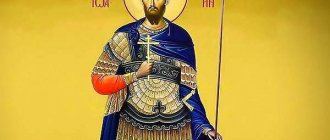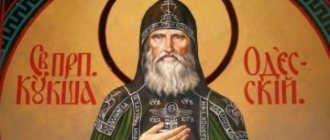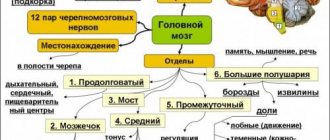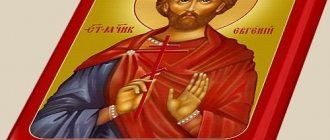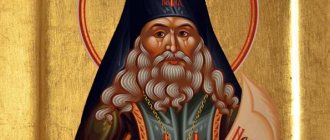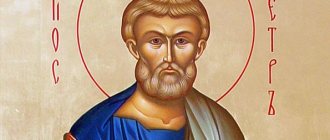The Life and Suffering of the Holy Martyr Longinus the Centurion
Memory October 16
When our Lord Jesus Christ, by His ineffable mercy, deigned to save us from destruction by His free suffering, the cross, death and resurrection, then one centurion, named Longinus, originally from Cappadocia, being under the authority of Pilate, was assigned with his soldiers to serve suffering and crucifixion of Jesus Christ. Having seen the miracles that took place at the cross of Christ: an earthquake, an eclipse of the sun, opened tombs and the dead rising from them, and the disintegration of stones, the centurion Longinus confessed that Christ is the Son of God. The Divine Evangelist Matthew says about this event: “The centurion and those who were guarding Jesus with him, seeing the earthquake and everything that happened, were greatly afraid and said: Truly this was the Son of God” (Matthew 27:54. Compare Mark 15 and Luke 23:47). This is how the Divine Gospel testifies to the centurion Longinus who believed in Christ. Church tradition adds to what is attested in the Gospel that Longinus was the warrior who pierced the ribs of the crucified Lord Jesus Christ and from the flowing blood and water received healing for his sore eyes. The same Longinus was also among the guards assigned by Pilate to the Life-giving body of Jesus Christ, which lay in the tomb. When the Lord gloriously rose from the tomb and brought terror to the guards with His miraculous uprising, 6730 then Longinus and the two soldiers finally believed in Christ and became preachers of the Resurrection of Christ, for they announced to Pilate and the bishops about everything that had happened. The bishops and elders, having held a meeting, gave the soldiers enough money so that they would hide the resurrection of Christ and say that Christ’s disciples, having come at night, stole Him while they were sleeping (Matthew 28:11-13). However, Longinus did not take the money and did not want to hide the miracle, but began to testify about it even more diligently, and his testimony was true. Therefore, Pilate and the entire Jewish host hated Longinus and all their anger, which they previously had against Christ, now turned to Longinus. Longinus openly preached about Christ that He is the True God, and that he, Longinus, was a witness of His life-giving death and resurrection. For this testimony, Longinus was subjected to hatred and persecution from the enemies of Jesus Christ, who began to look for a reason to destroy him, but, not finding guilt behind him, did not dare, because Longinus was the oldest of the warriors, an honest man and known to Caesar himself. When Longinus learned about their evil intentions, he wanted to be rejected from them and remain with Christ rather than live in the villages of Judea. He left his military rank, clothes and belt and, taking two of his friends who had the same zeal for Christ, withdrew from public communication and devoted himself to serving the One God. Having received baptism from the holy apostles, Longinus soon left Jerusalem and went with his friends to Cappadocia; there he became a preacher and apostle of Christ, and converted many from error to God. Then, leaving the city, Longinus began to live in his father’s village, spending a silent life - in fasting and prayer.
It soon became known to the entire Jewish congregation in Jerusalem that Longinus was spreading his teaching throughout Cappadocia and preaching about the resurrection of Christ. Then the bishops and elders of the Jews, filled with envy and anger, went to Pilate with many gifts and began to ask him to send a message to Caesar in Rome informing him that Longinus had rejected the military rank, refused to submit to Roman authority and was disturbing the people in Cappadocia, preaching to them about another king. Pilate, having accepted the gifts, agreed to the request of the Jews and sent a message to Caesar Tiberius6731 containing strong slander against Longinus. Along with this letter from Pilate, the Jews sent a lot of gold from themselves to Caesar and thereby bought the death of Saint Longinus: for soon a command came from Caesar Tiberius to put Longinus to death as an opponent of Caesar. Pilate immediately sent soldiers to Cappadocia to cut off the head of Longinus and bring it to Jerusalem to confirm the death of Longinus to the Jewish host. At the request of the Jews, Pilate also ordered the death of those two soldiers who, together with Longinus, left their military ranks and preached Christ with him in Cappadocia.
When the messengers reached the Cappadocia country, they began to diligently ask about Longinus, where he lives; Having learned that he was in his father’s village, they hurried there, trying to show that they were not looking for Longinus to kill, but as if to show him some honor. They were afraid that Longinus would escape their hands and that they would not return to those who sent them with nothing; That's why they wanted to seize him secretly.
Meanwhile, Saint Longinus, by revelation of God, learned about the crown of martyrdom that was being prepared for him. He himself came out to meet those sent from Pilate and greeted them kindly. Those, not knowing him, asked:
-Where is Longinus, who was once a centurion?
- Why do you need it? – Longinus asked them for his part.
“We heard,” the soldiers answered, “that he is a good man, and we want to visit him; we are warriors, and he was a centurion of warriors - that’s why we want to see him.
Then Longinus said:
“I ask you, my gentlemen, come to my house and rest a little from the road, and I will notify Longinus about you, for I know where he lives, and then he himself will come to you, since he lives not far from here.”
The warriors came to Longinus, and he offered them a rich treat. When evening came and the soldiers were greatly amused from the wine, they told Longinus why they had been sent. But first they asked him and took an oath from him that he would not tell this secret to anyone; the soldiers were afraid that someone would tell Longinus and that he would run away from them; at the same time they said to him:
“We have been sent to cut off the heads of Longinus and his two friends, for such a command came to Pilate from Caesar.
Longinus, hearing that they were trying to kill his friends too, sent for them quickly, inviting them to come to him; he himself did not want to tell the soldiers, until his friends came, that he was Longinus himself. When the soldiers fell asleep, Longinus began to pray, and all that night he fervently prayed to God, preparing for death. When morning came, the warriors, in a hurry to set off, asked Longinus to show them who they were looking for. Then Longinus said to them:
“Wait a little, my gentlemen,” I sent for him, and he will immediately come to you: believe me that the one you are looking for will give himself into your hands, “just wait a little.”
Then Longinus found out that his friends were coming: he immediately went out to meet them and, kissing them, hugged them and said:
- Rejoice, servants of Christ, my comrades-in-arms, rejoice with me, for our joy has come - the time has come for our release from carnal bonds; Now we will stand together before our Lord Jesus Christ. We saw Him suffering, crucified, buried and resurrected in glory; Now we will see him sitting at the right hand of God, and we will be satisfied with the sight of His glory.
Having said this to his friends, Longinus told them that soldiers had come from Pilate and the Jewish Sanhedrin to kill them for their testimony of the resurrection of Christ. Hearing this, they rejoiced that they would be worthy to be partakers of the crown of martyrdom and would soon appear before their Lord, whom they loved with all their souls. Having then brought his friends to the soldiers, Longinus said:
- Here's Longinus and his two friends! I am Longinus whom you seek; These are my two friends, who together with me saw the resurrection of Christ and believed; Do with us what those who sent you commanded you.
Hearing this, the soldiers were amazed and at first did not believe that Longinus himself was in front of them; then, having ascertained the truth of this, they were ashamed and did not want to kill their benefactor. But Longinus forced him to fulfill the command, saying:
“You can’t thank me better for my love for you than by sending me to my Lord, Whom I have long desired to see.”
Having then dressed himself in white funeral vestments and pointing his hand to a nearby hill, Longinus ordered his household to bury the body of him and his two friends there. After this, having prayed and given the last kiss to everyone, Longinus and his two friends bowed their heads under the sword. The soldiers, having beheaded them, took with them the head of Saint Longinus and left; the bodies of the saints were buried with honor in the place indicated by Saint Longinus himself.
Arriving in Jerusalem, the soldiers brought there the honest head of Saint Longinus and gave it to Pilate to certify him and the entire host of Jews in the murder of Longinus. Pilate and the Jews, seeing the head of the saint, ordered to throw it outside the city, and it lay there for a long time along with the rubbish until it was covered with dust.
The Lord “keeps all the bones” (Ps. 33:21) of His saints, and also kept intact the head of Saint Longinus, which was in the trash.
And when the Lord wanted to glorify His servant on earth before people, whom he had already glorified in heaven before the angels, he opened the head of the saint in this way. One woman, a Christian widow from Cappadocia, became blind in both eyes and sought help from doctors for a long time, but did not receive it. After this, she decided to go to Jerusalem - to venerate the holy places and seek God’s help there for her blinded eyes. Taking her only son, she set off with him. But having reached the holy places, her son fell ill and died a few days later; That widow was bitterly saddened by the death of her son: she cried over a double loss, for she had lost both her eyes and her son, who was like a light for her eyes and a guide for her. And so, when that widow wept bitterly and inconsolably, Saint Longinus appeared to her in a vision and consoled her, promising her that she would see her son in heavenly glory and receive light in her eyes. He told her everything about himself: how he was at the suffering, crucifixion, burial and resurrection of Christ, how, then, he preached Christ in Cappadocia and suffered for Him with his friends. At the same time, he ordered her to go outside the city and find his head there, lying in rubbish and covered with dust.
“It is destined for you,” said Saint Longinus, “to find it for your healing.”
Comforted from her sadness, the widow stood up and asked to be escorted out of the city; when they led her there, she said to those accompanying her:
“Where you see a big pile of swept-up rubbish, put me there.”
They did just that. Having found a large amount of swept-up rubbish, they brought her there, and she began to rake away the rubbish and dig up the dust with her own hands: although she did not see anything with her eyes, she had great faith in the words spoken to her in a vision by Saint Longinus. And immediately, at the discretion of God, she received what she was looking for and suddenly saw the light of the sun; for her eyes were opened and she saw the head of the saint lying in the dust. The widow was glad not so much because she saw the light of the sun, but because she found the head of the saint, thanks to which she received insight. And she glorified God and magnified His servant - Saint Longinus.
Having taken and kissed the head of the saint, the woman joyfully carried it to her home; She washed her, anointed her with fragrant ointments, and rejoiced so much at finding this spiritual treasure that she forgot her sadness about her dead son. The next night Saint Longinus again appeared to her in great light, brought her son to her, in shining wedding clothes, and lovingly and fatherly embracing him, said to the widow:
“Look, wife, at your son, about whom you grieve and cry: behold, what an honor and glory he is—look at him and be comforted.” God ranked him among the heavenly ranks that are in His Kingdom. Now I have taken it from the Savior, and it will never be removed from me. Behold, take my head and the body of your son, and bury them in one ark, and do not cry for your only son, and do not let your heart be troubled, for great glory, joy and endless joy have been given to him from God6733.
When the woman heard this, she hastily stood up and placed the head of the martyr in the same ark with the body of her dead son and then returned to her home, glorifying and praising God. Having reached her fatherland, she buried the body of her son and the head of the martyr in an honest place, thinking thus:
– Now I know that “all things work together for good to those who love God, to those who are the called according to [His] purpose” (Rom. 8:28): I sought healing for the eyes of the body, and at the same time I found healing for the eyes of the soul. I was overwhelmed with grief over the death of my son, but now I have him in heaven, standing before God in glory, with the prophets and martyrs; with them he always rejoices and with Longinus in the Kingdom of Christ bears the cross - a sign of victory, among the angels, and as a disciple of Longinus joyfully sings: “truly this Son of God is” and is and will be. His kingdom is the kingdom of all ages and His dominion in every generation and generation. Glory to Him forever. Amen6734.
Kontakion, tone 4:
The church rejoiced joyfully, today in memory of the ever-memorable sufferer Longinus, crying: you are my power, Christ, and affirmation.
Apocryphal evidence
In apocryphal literature, the earliest mention of this episode is found in the Latin version of the Acts of Pilate, part of the Gospel of Nicodemus. The Roman soldier who pierced the body of Jesus is named in this apocrypha by name: the centurion Longinus
. In Western tradition he is identified with the centurion mentioned in the Gospels of Matthew (27:54), Mark (15:39), and Luke (23:47). According to one of the hagiographic texts attributed to Hesychius of Jerusalem, the centurion Longinus repented and converted immediately after the death of Jesus Christ, frightened by the subsequent eclipse and earthquake, became a preacher of Christianity and was killed in Caesarea Cappadocia in 58, from where, according to other testimonies, he was originally from[1][2].
One of the earliest depictions of the crucifixion scene, a miniature from the Gospel of Rabula, an illuminated Syriac manuscript of the 6th century, includes the name of the soldier inscribed above his head in Greek in a modified form: Login, ΛΟΓΙΝΟΣ (it is possible, however, that the name could have been added in miniature later).
Description of Longinus' act in the Gospel
The New Testament, which describes the events of 33 AD, mentions Longinus the Centurion only once. In the Gospel of John, the scene of the piercing of the chest of Jesus Christ with a spear is revealed in the following text:
In. 19:31-37
But since [then] it was Friday, the Jews, in order not to leave the bodies on the cross on Saturday - for that Saturday was a great day - asked Pilate to break their legs and take them off. So the soldiers came and broke the legs of the first, and of the other who was crucified with Him. But when they came to Jesus, when they saw Him already dead, they did not break His legs, but one of the soldiers pierced His ribs with a spear, and immediately blood and water flowed out. And he who saw it bore witness, and his testimony is true; he knows that he speaks the truth so that you may believe. For this happened, that the Scripture might be fulfilled: Let not His bone be broken. Also in another [place] Scripture says: They will look at Him whom they have pierced.
Notes
- Boris Derevensky.
Jesus Christ in the documents of history. - St. Petersburg: Aletheia, 2007. - ISBN 978-5-903354-20-7, p.Places Garden of Gethsemane • Sanhedrin • Golgotha Jesus and disciples Jesus Christ • Virgin Mary • Mary Magdalene • Mary of Cleopas • John the Theologian • Apostle Peter • Apostle Mark • Judas Iscariot • Myrrh-Bearing Women Jews Herod Antipas • Caiaphas • Annas • Malchus • Servant the Doorkeeper • Barabbas • Simon of Cyrene • Ahasuerus • The Prudent and the Mad Robbers Romans Pontius Pilate • Claudius Proculus • Centurion Longinus Items Instruments of the Passion: Crown of Thorns • Robe of the Lord/Seamless Chiton • Life-Giving Cross • Titlo INRI • Spear of Longinus • Holy Grail • Thirty Pieces of Silver Iconography Ecce Homo • Shape of the cross of Jesus Christ • Crucifixion (decorative arts)
Gallery
- 0 Statue de Saint Longin par Gian Lorenzo Bernini – Basilique St-Pierre – Vatican.jpg
Saint Longinus sculpture by G. Bernini in St. Peter's Basilica
- Fra Angelico 027.jpg
Longinus piercing the chest of Christ, fragment of a fresco by Fra Angelico
- Mathis Gothart Grünewald 047.jpg
Christ on the Cross, Three Marys, Evangelist John and St. Longinus Matthias Grunewald
- Sao Longuinhos - Bom Jesus.jpg
Saint Longinus in the Cathedral of Bom Jesus do Monti[en], Braga, Portugal
- Longinus (Russia, 19 c).jpg
Centurion Longinus Russian wooden sculpture, 19th century
Reverence
In the Orthodox Church
The Orthodox Church honors Longinus as a martyr. The martyr Longinus is commemorated on October 29 (October 16 according to the Julian calendar).
Thy martyr, Lord, Longinus, in his suffering received an imperishable crown from Thee, our God: having Thy strength, overthrow the tormentors, crush the demons of weak insolence.
Save his souls with our prayers. — Troparion of the Martyr Longinus the Centurion
At the proskomedia during the preparation of the Lamb, the obligatory actions include piercing the right side of the Lamb with a copy and pronouncing the gospel words about the actions of Longinus at the crucifixion of Christ (John 19:34).
One of the chapels of the Church of the Holy Sepulcher in Jerusalem is dedicated to Saint Longinus.
In the Catholic Church
In the Middle Ages, the veneration of Saint Longinus was widespread in Western Europe. This was not least due to the inclusion of the story of Saint Longinus in the Golden Legend, a popular collection of lives. Currently, the memory of Saint Longinus is celebrated in the Catholic Church on March 15th.
The relics, venerated in the West as those of St. Longinus, are kept in the Roman Church of St. Augustine. The Vatican's St. Peter's Basilica houses the tip of Longinus' spear and a statue of the saint created by Bernini.
